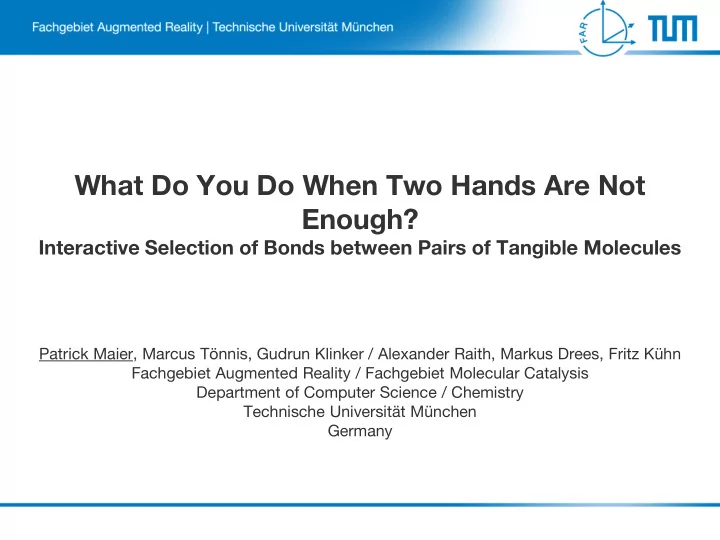

What Do You Do When Two Hands Are Not Enough? Interactive Selection of Bonds between Pairs of Tangible Molecules Patrick Maier, Marcus Tönnis, Gudrun Klinker / Alexander Raith, Markus Drees, Fritz Kühn Fachgebiet Augmented Reality / Fachgebiet Molecular Catalysis Department of Computer Science / Chemistry Technische Universität München Germany
Overview 1. Project “Tangible Chemical Reactions” 2. Problems with Two Handed Interactions 3. Problem in Selecting with Controlled Objects - Proximity Based Selection - Shake Based Selection 4. Evaluation and User Study Tangible Chemical Reactions 2
Project “Tangible Chemical Reactions” „ Intention: - Help chemists in designing catalysts - Help students in learning/understanding chemistry „ Methods: - Visualize and control models of molecules in 3D - Show the dynamic behavior of the molecules „ Desired results: - Speed up the process of designing new molecules - Help to improve the understanding of chemistry Tangible Chemical Reactions 3
Project “Tangible Chemical Reactions” „ Show molecules on top of the markers. „ Possible bonds are shown (right picture) Tangible Chemical Reactions 4
Problem in Selecting a single Bond between Molecules Separate molecule models All possible bonds are shown Problem: „ How to select one possible bond out of the whole set of possible bonds? Tangible Chemical Reactions 5
Problems with Two Handed Interaction „ Only two hands available „ Hands occupied by holding the markers „ How to tell the system to select or trigger an event on a controlled object? This could be done in several ways: Speech, foot pedals, putting on table, … But we focus on gestures, when hands are not free. Tangible Chemical Reactions 6
Selection with Controlled Objects Problem: How to select a possible bond? Approaches: „ Proximity Based „ Shake Based Tangible Chemical Reactions 7
Proximity Based Selection „ Freely move the molecules towards each other. „ All atoms which are able to bind and … „ … which are closer than a specific distance are possible binding partners. „ The shortest possible bond between these possible binding partners (atoms) is selected. Tangible Chemical Reactions 8
Shake Based Selection „ Move the molecules towards each other „ All atoms which are able to bind and … „ … which are closer than a specific distance are possible binding partners. „ Perform a shaking gesture to cycle through the possible binding partners (atoms). „ The possible bond, connecting these binding partners, is selected. Find a way to trigger the shaking gesture… Tangible Chemical Reactions 9
Recognition of the Shaking Gesture Comparison of the trajectory length of the last second and its compactness: Normal Movement: Shaking: Trajectory length high and not compact Trajectory length high but compact Tangible Chemical Reactions 10
Recognition of the Shaking Gesture • Scatterplot showing the trajectory length and the spread value (inverse compactness). Configuration, where Shaking was recognized Tangible Chemical Reactions 11
Recognition of the Shaking Gesture • Dynamic hysteresis to prevent multiple triggering. • Moving hysteresis window - Scatter value goes below lower window boundaries window lowers - Scatter value goes above upper window boundaries window raises • Only trigger again, when the window was raised after a triggered event. Scatter value Trigger threshold Triggered gestures Tangible Chemical Reactions 12
User Study „ Task: - Within-subject, repeated measures single-session design. - 19 Users (7 female, 12 male) - Select possible bonds which are given by the application - 24 combinations to select with proximity based selection - 24 combinations to select with shake based selection - How fast are both methods? - How accurate are they? Tangible Chemical Reactions 13
User Study – Measure Speed „ Differentiate combinations between: - all atoms - atoms and a center atom - only outer atoms „ Proximity based is faster, except for combinations with center atom. Tangible Chemical Reactions 14
User Study – Accuracy „ More errors with proximity based method „ Except combinations with only outer atoms Tangible Chemical Reactions 15
Conclusion & Future Work Both methods have their pros and cons: „ Proximity based method: - is fast and easy on combinations with only outer atoms. - is difficult and frustrating with combinations with center atom. „ Shake based method: - is accurate in selecting the desired bond, - but slow. Future Work: „ Combine both methods to get speed and accuracy, „ by introducing layers (like shells), and switching layers by shaking, „ Use proximity based method to select bonds from the selected layers „ Find ways to confirm the selection and connect the molecules. Tangible Chemical Reactions 16
Another solution: When two hands are not enough… ask someone to help you : -) Thank You Tangible Chemical Reactions 17
Recommend
More recommend